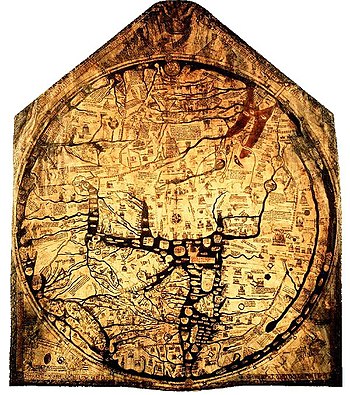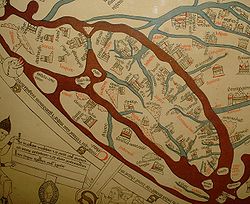Hereford Mappa Mundi

The Hereford Mappa Mundi is a mappa mundi, of a form deriving from the T and O pattern, dating to ca. 1300. It is currently on display in Hereford Cathedral in Hereford, England.
Features
The map is signed by or attributed to one "Richard of Haldingham and Lafford", also known as Richard de Bello, "prebend of Lafford in Lincoln Cathedral". Drawn on a single sheet of vellum, it measures 158 cm by 133 cm, and is the largest medieval map known to still exist. The writing is in black ink, with additional red and gold, and blue or green for water [with the Red Sea (8) coloured red].
Jerusalem is drawn at the centre of the circle, East is on top, showing the Garden of Eden in a circle at the edge of the world (1). Great Britain is drawn at the north-western border (bottom left, 22 & 23). Curiously, the labels for Africa and Europe are reversed, with Europe scribed in red and gold as 'Africa', and vice-versa.
The map is based on traditional accounts and earlier maps such as the one of the Beatus of Liébana codex, and is very similar to the Ebstorf map, the Psalter world map, and the Sawley (erroneously for considerable time called "Henry of Mainz") map; it does not correspond to the geographical knowledge of the 1300s. Note, for example, that the Caspian Sea (5) connects to the encircling Ocean (upper left). This is in spite of William of Rubruk's having reported it to be landlocked in 1255, i.e. several decades before the map's creation; see also Portolan chart.
The "T and O" shape does not imply that its creators believed in a flat Earth. The spherical shape of the Earth was already known to the ancient Greeks and Romans and the idea was never entirely forgotten even in the Middle Ages, and thus the circular representation may well be considered a conventional attempt at a projection: in spite of the acceptance of a spherical Earth, only the known parts of the northern hemisphere were believed to be inhabitable by human beings (see antipodes), so that the circular representation remained adequate. The long river on the far right is the River Nile, too (12), and the T shape is established by the Mediterranean (19-21-25) and the rivers Don (13) and Nile (16). It is the first map to mention the Faroe Islands.
Locations

0 - At the centre of the map: Jerusalem, above it: the crucifix.
1 - The Paradise, surrounded by a wall and a ring of fire.
2 - The Ganges and its delta.
3 - The fabulous Island of Taphana, sometimes interpreted as Sri Lanka or Sumatra.
4 - Rivers Indus and Tigris.
5 - The Caspian Sea, and the land of Gog and Magog
6 - Babylon and the Euphrates.
7 - The Persian Gulf.
8 - The Red Sea (painted in Red).
9 - Noah's Ark.
10 - The Dead Sea, Sodom and Gomorrah, with River Jordan, coming from Sea of Galiliee; above: Lot's wife.
11 - Egypt with the River Nile.
12 - River Nile [?], or possibly an allusion to the equatorial Ocean; far outside: a land of mutants, possibly the Antipodes.
13 - The Azov Sea with Rivers Don and Dnjepr; above: the Golden Fleece.
14 - Constantinople; left of it the Danube's delta.
15 - The Aegean Sea.
16 - Oversized delta of the Nile with Alexandria's Lighthouse.
17 - The legendary Norwegian Gansmir, with his skis and ski pole.

18 - Greece with Mt. Olympus, Athens, and Corinth
19 - Misplaced Crete with Minotaur's circular labyrinth.
20 - The Adriatic Sea; Italy with Rome, honoured by a popular hexameter: Roma caput mundi tenet orbis frena rotundi [Rome, the head, holds the reins of the world].
21 - Sicily and Carthage, opposing Rome, right of it.
22 - Scotland.
23 - England.
24 - Ireland.
25 - The Balearic Islands.
26 - The Straits of Gibraltar (the Pillars of Hercules).
Further reading
A series of close-up photographs of the entire map, along with annotated transcriptions and English translations of all the text thereon, have been published in Scott D. Westrem, The Hereford Map, Terrarum Orbis 1 (Turnhout: Brepols, 2001) ISBN 2-503-51056-6.
